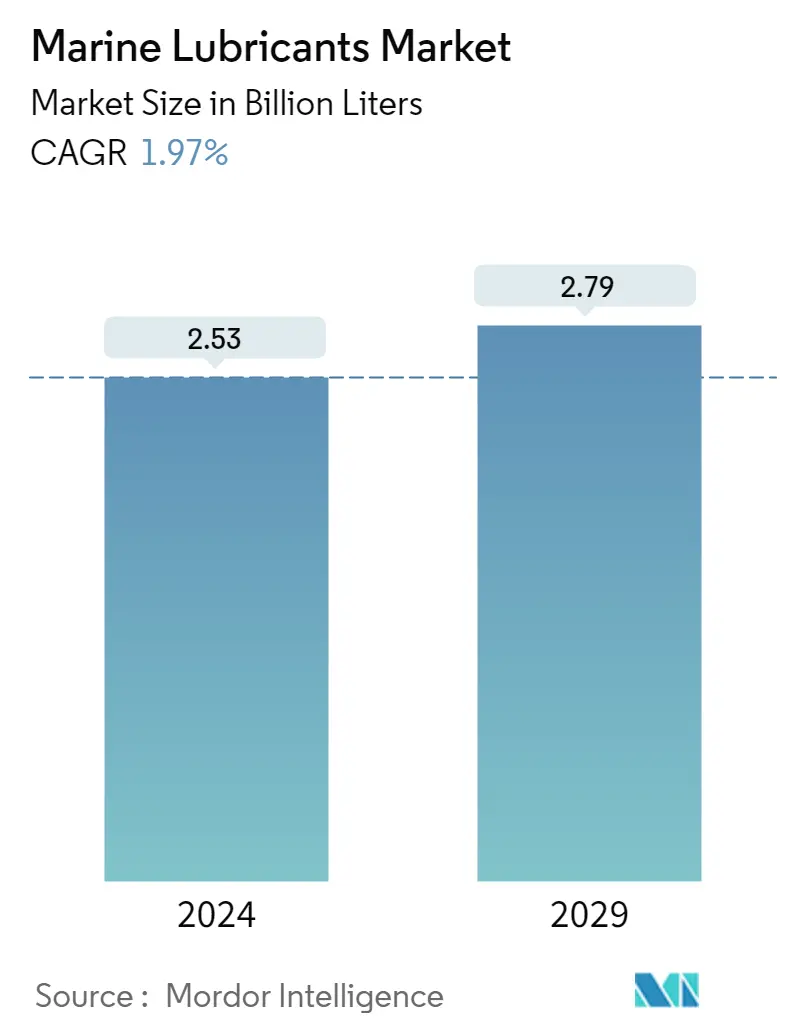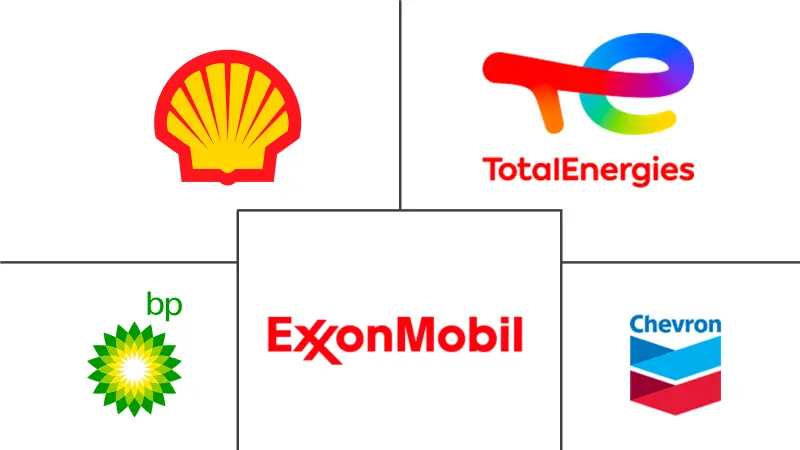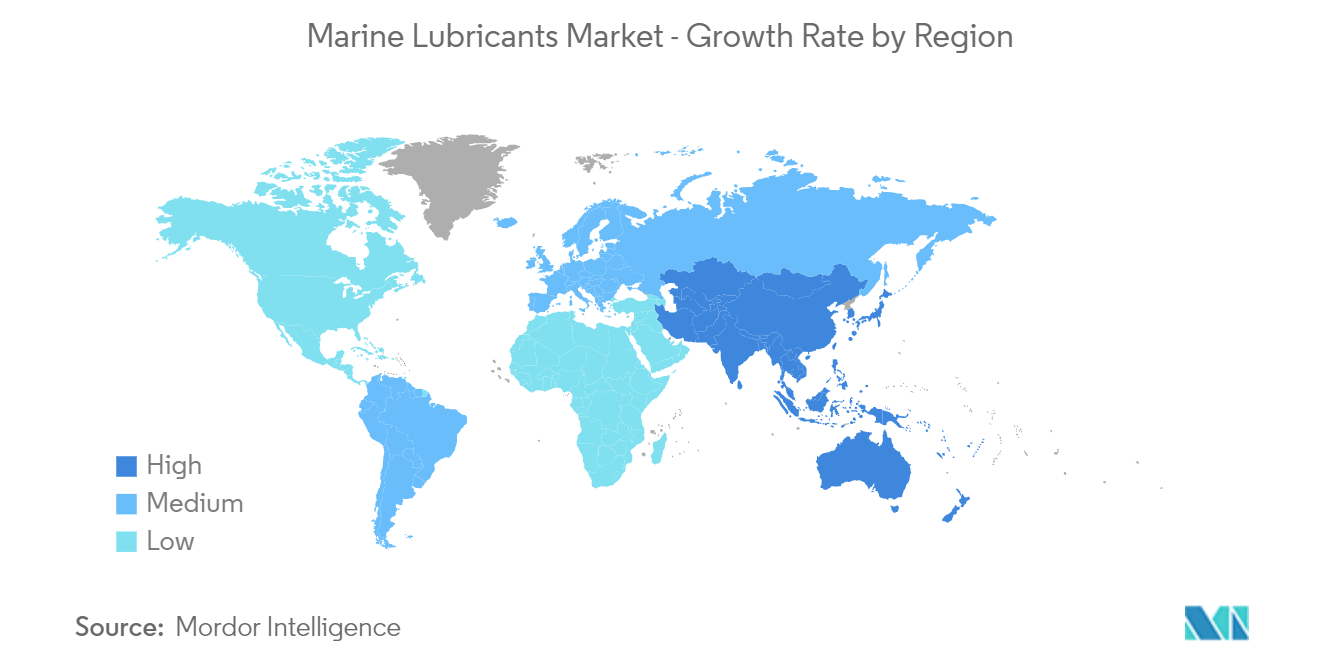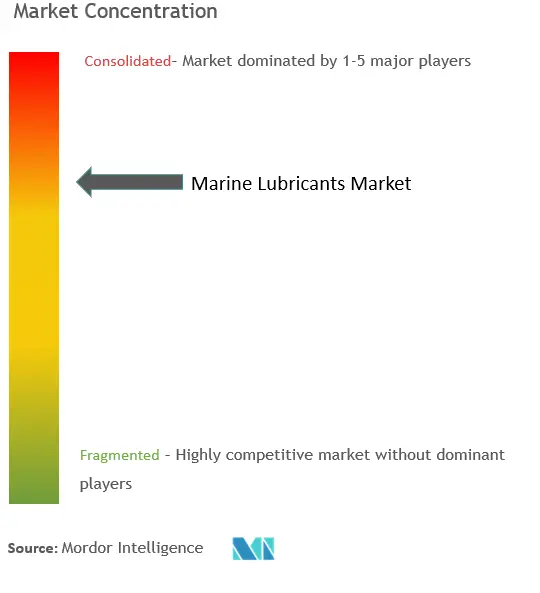Marine Lubricants Market Size

| Study Period | 2019 - 2029 |
| Base Year For Estimation | 2023 |
| CAGR (2024 - 2029) | 1.97 % |
| Fastest Growing Market | Asia Pacific |
| Largest Market | Asia Pacific |
| Market Concentration | Low |
Major Players
*Disclaimer: Major Players sorted in no particular order |
Marine Lubricants Market Analysis
The Marine Lubricants Market size is estimated at 2.53 Billion liters in 2024, and is expected to reach 2.79 Billion liters by 2029, growing at a CAGR of 1.97% during the forecast period (2024-2029).
The COVID-19 pandemic negatively impacted the market. It was because of the shutdown of the manufacturing facilities and plants due to the lockdown and restrictions. Supply chain and transportation disruptions further created hindrances for the market. However, the industry witnessed a recovery in 2021, thus rebounding the demand for the market studied.
- Over the short term, the rising demand for marine transport in Europe and Asia-Pacific and growing shipbuilding activities in Asia-Pacific are expected to drive the market demand during the forecast period.
- On the flip side, the development of synthetic and bio-based lubricants and volatility in raw material prices are anticipated to hinder the market's growth.
- However, the recovering shipbuilding and marine transport industries in the United States are projected to act as an opportunity for the market in the coming years.
- The Asia-Pacific region is expected to dominate the market and will also witness the highest CAGR during the forecast period.
Marine Lubricants Market Trends
The Marine Cylinder Lubricant Segment is Expected to Dominate the Market
- Marine cylinder lubricants occupy the largest share of the market. These lubricants find their applications in vessels with either 2-stroke or 4-stroke engines, with 2-stroke engines occupying most of the share. For many years, the two-stroke crosshead diesel engine is the preferred prime mover for larger merchant vessels.
- For marine diesel engines operating on residual fuels containing sulfur, cylinder lubricants generally serve the following purposes:
- Form and maintain an oil film to prevent metal-to-metal contact between the cylinder liner and piston rings.
- Neutralize sulfuric acid to control corrosion.
- Clean the cylinder liner, particularly the piston ring pack, to prevent malfunction and damage caused by combustion and neutralization residues.
- The ever-tightening restrictions regarding the environment are pushing marine cylinder lubricant manufacturers to develop new products continuously. Major manufacturers, such as Shell and Castrol, even responded to the restrictions laid out by offering newer products to their customers over recent years.
- With the growing naval trade globally, the merchant navy fleet is continuously increasing, which may increase the consumption of marine cylinder lubricants.
- Two-stroke engines are used in merchant fleets, including oil tankers, cargo ships, bulk carriers, and others. According to the United Nations Conference on Trade and Development (UNCTAD), the world merchant fleet had reached a carrying capacity of 2.2 billion dead-weight tons (DWT) in January 2022, which was 63 dead-weight tons (DWT) more compared to the previous year. It led to increased consumption of marine cylinder lubricants used in the engines of the merchant fleet, which in turn, stimulated the demand in the studied market.
- According to Marine Flottenkommando, as of January 2022, the total number of merchant ships amounted to 58,228 units globally. It reached about 53,973 merchant ships in 2021, with a growth rate of about 7.8%. It led to an increase in the consumption of marine cylinder lubricants, which drives the marine lubricants market.
- Moreover, over the past decade, the number of container ships in the global fleet reached 5,589 in 2022. Based on the chartered twenty-foot equivalent units (TEUs), Mediterranean Shipping Co. is the leading container ship operator worldwide.
- Therefore, the factors above are expected to significantly impact the market in the coming years.

Asia-Pacific Region is Expected to Dominate the Market
- The Asia-Pacific region dominated the marine lubricants market. With rising demand in most industries and commodities, an increasing trend for imports and exports is registered in recent years.
- The demand for basic commodities and raw materials, including crude oil and natural gas, rose. In line with the Paris Climate Pact, the major developing nations of Asia-Pacific are cutting down their daily usage of coal and converting it to natural gas, majorly for power generation and cooking purposes. Natural gas is imported into Asia-Pacific, as the production is insufficient to cope with the demand.
- Lubricants are used in marine applications, including engine oils, air compressors, hydraulic systems, turbines, gear systems, bearings, circulation systems, etc.
- According to the United Nations Conference on Trade and Development (UNCTAD), in terms of dead-weight tons (DWT), about 94% of the global shipbuilding activities were located in China, the Republic of Korea, and Japan. Furthermore, Bangladesh and India accounted for about 71% of global ship recycling.
- According to UNCTAD, China had 1,15,154 merchant ships in 2022, which showed an increase of around 6.1% compared to 2021, amounting to 1,08,481 merchant ships. Therefore, this is expected to create an upside demand for the marine lubricants market.
- In June 2022, China launched its third advanced air carrier Fujian from Shanghai's Jiangnan Shipyard. The Fujian is China's first domestically designed and built catapult aircraft carrier.
- Therefore, the factors above are expected to significantly impact the market in the coming years.

Marine Lubricants Industry Overview
The marine lubricants market is partially consolidated in nature. Some of the key players in the market (not in a particular order) include Exxon Mobil Corporation, BP p.l.c. (Castrol), Shell PLC, Chevron Corporation, and TotalEnergies, among others.
Marine Lubricants Market Leaders
-
Chevron Corporation
-
Exxon Mobil Corporation
-
Shell PLC
-
BP p.l.c. (Castrol)
-
TotalEnergies
*Disclaimer: Major Players sorted in no particular order

Marine Lubricants Market News
- February 2023: Luberef announced that expanding its base oil plant in Yanbu' al Bahr, Saudi Arabia, will increase capacity by 230,000 metric tons annually. The refiner, a subsidiary of Saudi Aramco, said the project would also upgrade the facility, enabling it to make API Group III base stocks.
- June 2022: China launched its third advanced air carrier Fujian from Shanghai's Jiangnan Shipyard. The Fujian is China's first domestically designed and built catapult aircraft carrier.
- April 2022: Chevron Global Energy Inc., a fully owned subsidiary of Chevron Corporation, completed the previously announced acquisition of Neste Corporation's NEXBASE brand, associated qualifications and approvals, and related sales and marketing operations from Neste Corporation.
Marine Lubricants Market Report - Table of Contents
1. INTRODUCTION
- 1.1 Study Assumptions
- 1.2 Scope of the Study
2. RESEARCH METHODOLOGY
3. EXECUTIVE SUMMARY
4. MARKET DYNAMICS
-
4.1 Drivers
- 4.1.1 Rising Demand for Marine Transport in Europe and Asia-Pacific
- 4.1.2 Growing Shipbuilding Activities in Asia-Pacific
- 4.1.3 Other Drivers
-
4.2 Restraints
- 4.2.1 The Development of Synthetic Lubricants and Bio-Based Lubricants
- 4.2.2 Volatility in Raw Material Prices
- 4.2.3 Other Restraints
- 4.3 Industry Value Chain Analysis
-
4.4 Porter's Five Forces Analysis
- 4.4.1 Bargaining Power of Suppliers
- 4.4.2 Bargaining Power of Buyers
- 4.4.3 Threat of New Entrants
- 4.4.4 Threat of Substitute Products and Services
- 4.4.5 Degree of Competition
5. MARKET SEGMENTATION (Market Size in Volume)
-
5.1 Lubricant Type
- 5.1.1 System Oil
- 5.1.2 Marine Cylinder Lubricant
- 5.1.3 Trunk Piston Engine Oil
- 5.1.4 Other Lubricant Types
-
5.2 Ship Type
- 5.2.1 Bulker
- 5.2.2 Tanker
- 5.2.3 Container
- 5.2.4 Other Ship Types
-
5.3 Geography
- 5.3.1 Asia-Pacific
- 5.3.1.1 China
- 5.3.1.2 India
- 5.3.1.3 Japan
- 5.3.1.4 South Korea
- 5.3.1.5 Rest of Asia-Pacific
- 5.3.2 North America
- 5.3.2.1 United States
- 5.3.2.2 Mexico
- 5.3.2.3 Canada
- 5.3.3 Europe
- 5.3.3.1 Germany
- 5.3.3.2 United Kingdom
- 5.3.3.3 France
- 5.3.3.4 Italy
- 5.3.3.5 Rest of Europe
- 5.3.4 South America
- 5.3.4.1 Brazil
- 5.3.4.2 Argentina
- 5.3.4.3 Rest of South America
- 5.3.5 Middle East and Africa
- 5.3.5.1 Saudi Arabia
- 5.3.5.2 South Africa
- 5.3.5.3 Rest of Middle East and Africa
6. COMPETITIVE LANDSCAPE
- 6.1 Mergers and Acquisitions, Joint Ventures, Collaborations, and Agreements
- 6.2 Market Share (%)**/Ranking Analysis
- 6.3 Strategies Adopted by Leading Players
-
6.4 Company Profiles
- 6.4.1 BP p.l.c. (Castrol)
- 6.4.2 Chevron Corporation
- 6.4.3 China Petrochemical Corporation (SINOPEC)
- 6.4.4 ENEOS Corporation
- 6.4.5 Exxon Mobil Corporation
- 6.4.6 FUCHS
- 6.4.7 Gazprom Neft PJSC
- 6.4.8 Gulf Oil International Ltd
- 6.4.9 Idemitsu Kosan Co.,Ltd
- 6.4.10 Indian Oil Corporation Ltd
- 6.4.11 LUKOIL
- 6.4.12 Shell PLC
- 6.4.13 Total Energies SE
- *List Not Exhaustive
7. MARKET OPPORTUNITIES AND FUTURE TRENDS
- 7.1 Expansion of Naval Strength in Different Countries
- 7.2 Other Opportunities
Marine Lubricants Industry Segmentation
Marine lubricants are used in different sections and processes of containers, cargo fleets, oil tankers, and other ships for lubrication purposes. Marine lubricants include engine oils, hydraulic oils, compressor oils, slideways oils, gear oils, heat transfer oils, greases, turbine oils, and others. The marine lubricant market is segmented by lubricant type, ship type, and geography. By lubricant type, the market is segmented into system oil, marine cylinder lubricant, trunk piston engine oil, and other lubricant types. The market is segmented by ship type into bulker, tanker, container, and other ship types. The report also covers the market size and forecasts for marine lubricants in 15 countries across the major regions. Each segment's market sizing and forecasts are based on volume (million liters).
| Lubricant Type | System Oil | |
| Marine Cylinder Lubricant | ||
| Trunk Piston Engine Oil | ||
| Other Lubricant Types | ||
| Ship Type | Bulker | |
| Tanker | ||
| Container | ||
| Other Ship Types | ||
| Geography | Asia-Pacific | China |
| India | ||
| Japan | ||
| South Korea | ||
| Rest of Asia-Pacific | ||
| Geography | North America | United States |
| Mexico | ||
| Canada | ||
| Geography | Europe | Germany |
| United Kingdom | ||
| France | ||
| Italy | ||
| Rest of Europe | ||
| Geography | South America | Brazil |
| Argentina | ||
| Rest of South America | ||
| Geography | Middle East and Africa | Saudi Arabia |
| South Africa | ||
| Rest of Middle East and Africa |
Marine Lubricants Market Research FAQs
How big is the Marine Lubricants Market?
The Marine Lubricants Market size is expected to reach 2.53 billion liters in 2024 and grow at a CAGR of 1.97% to reach 2.79 billion liters by 2029.
What is the current Marine Lubricants Market size?
In 2024, the Marine Lubricants Market size is expected to reach 2.53 billion liters.
Who are the key players in Marine Lubricants Market?
Chevron Corporation, Exxon Mobil Corporation, Shell PLC, BP p.l.c. (Castrol) and TotalEnergies are the major companies operating in the Marine Lubricants Market.
Which is the fastest growing region in Marine Lubricants Market?
Asia Pacific is estimated to grow at the highest CAGR over the forecast period (2024-2029).
Which region has the biggest share in Marine Lubricants Market?
In 2024, the Asia Pacific accounts for the largest market share in Marine Lubricants Market.
What years does this Marine Lubricants Market cover, and what was the market size in 2023?
In 2023, the Marine Lubricants Market size was estimated at 2.48 billion liters. The report covers the Marine Lubricants Market historical market size for years: 2019, 2020, 2021, 2022 and 2023. The report also forecasts the Marine Lubricants Market size for years: 2024, 2025, 2026, 2027, 2028 and 2029.
Marine Lubricants Industry Report
The Marine Lubricants Market is segmented by lubricant type, ship type, and geography. The report offers market sizes and forecasts in volume for all the segments. This industry report provides a comprehensive market overview, including detailed market segmentation and market analysis. The report highlights market growth, market trends, and market leaders, offering a valuable market forecast.
Our industry analysis reveals key insights into the market share and market size, providing a thorough industry outlook. The report includes industry statistics and industry information, ensuring a complete understanding of the market value and market data.
In addition to the market review, the report also covers market predictions and market outlook, offering a forward-looking perspective on the industry. The industry research includes industry sales and industry size, providing a holistic view of the market.
The report PDF is available for download, offering a detailed report example and a comprehensive industry overview. This industry research is essential for understanding the market forecast and market growth, providing valuable industry trends and market segmentation.
The market report is a crucial resource for research companies, offering in-depth industry reports and industry statistics. The report also includes a sample of the industry analysis, providing a glimpse into the industry research and market data.



